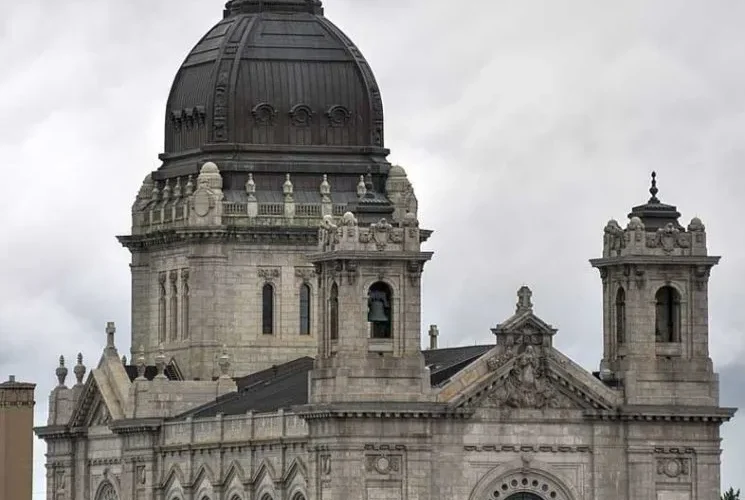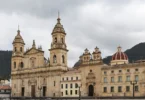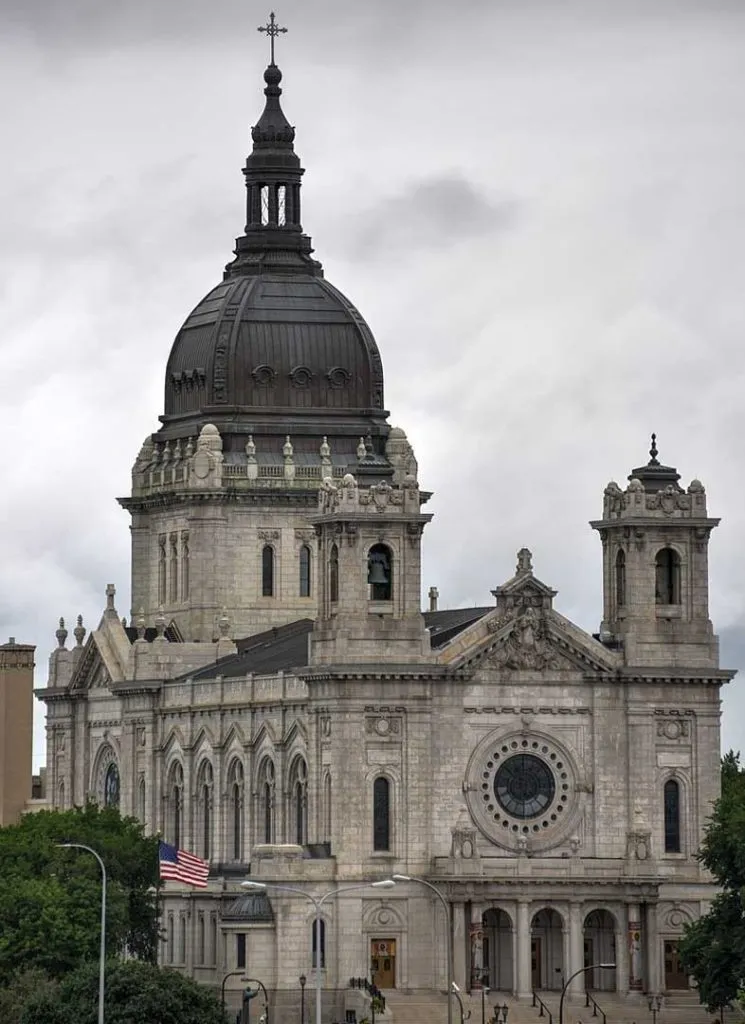
Introduction
The Basilica of Saint Mary, Minneapolis is a Roman Catholic Minor Basilica located on its own city block along Hennepin Avenue between 16th & 17th Streets in downtown Minneapolis, Minnesota. It was the first basilica established in the United States. The Basilica of Saint Mary is the co-cathedral of the Roman Catholic Archdiocese of Saint Paul and Minneapolis is one of the finest examples of Beaux-Arts architecture in the country.
The Basilica of Saint Mary, Minneapolis replaced a previous church, the Church of the Immaculate Conception. The building was added to the National Register of Historic Places in 1975. Its significance is due to three reasons: its excellent architecture and engineering design, as an expression of Baroque influence in church architecture; an example of the history of religious movements in Minnesota; and its place as the first basilica in the United States.
The foundation of the church is of Rockville granite. The walls of the Basilica of St. Mary, Minneapolis are built of white Vermont granite, with a height of 70 feet from the floor to the eave-line. The main entrance is a colonnaded portico with two 116-foot spires on each side. The nave is lighted by five large arched stained glass windows. The nave has a barrel vault of 82 feet, exceeding that of the St. Peter’s Basilica by two feet. The sanctuary, at the north end of the nave, is topped with a grand dome measuring 40 feet square at the base and rising 138 feet above the floor.
The Basilica of Saint Mary, Minneapolis was commissioned by Archbishop Ireland (1838-1918) and designed by French architect Emmanuel Masqueray (1861-1917) in a beaux-arts style. It was intended to house the relocated parish of the Immaculate Conception, founded in 1868.
The building was constructed between 1907-1915. Interior work, begun in 1922, was near completion when Pope Pius XI named the church the first Basilica in the United States on February 1, 1926.
- A place of worship.
- A place of refuge.
- A place of peace.
More than just a beautiful building, The Basilica of Saint Mary is a gathering place of rich diversity. It’s a centre for the arts and a place of refuge for people in need. It’s a community committed to the growth and well-being of the city.
Together, we celebrate weddings, baptisms and funerals, Christmas and Easter, and weekend Eucharist.
With over 6,700 households, the Basilica has an active vision for social outreach. St. Vincent de Paul society offers compassionate assistance for basic needs since 1988. The Basilica offer mentoring, direct service, employment support and partner with community non-profits. Relationship support is offered to strengthen stability in life through Pathways Life Skills.
John XXIII Art Gallery features local, national and international artists work, and music is available to all through our Spirit and Soul celebration of Black History Month, the Minnesota Sinfonia, The Singers, The Rose Ensemble and others who offer free and low-cost concerts.
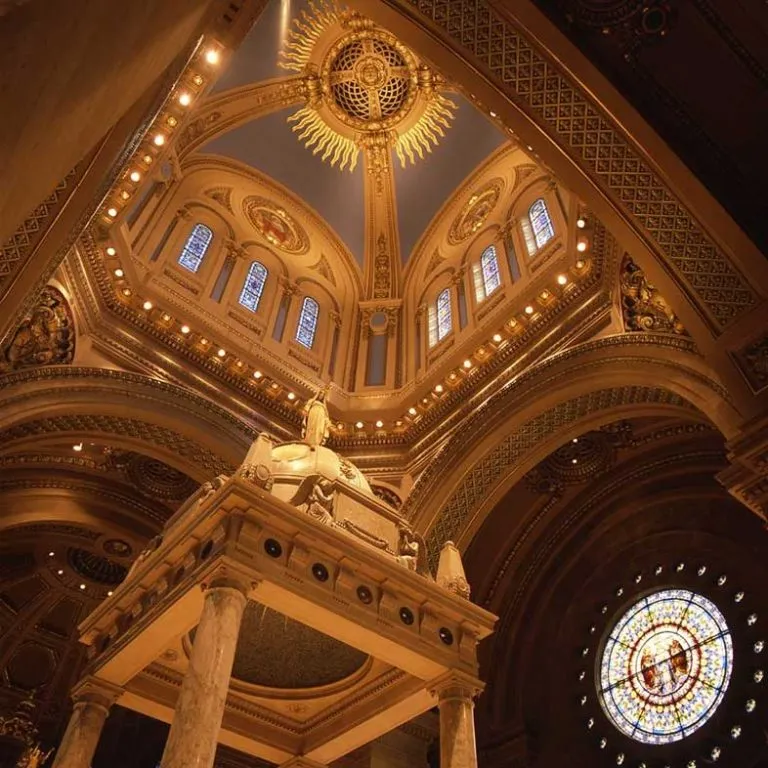
History of the Basilica of St. Mary, Minneapolis
The Basilica of Saint Mary, Minneapolis replaced a previous church, the Church of the Immaculate Conception. It was originally built in 1871, located at 3rd Street and 3rd Avenue North, but the expanding warehouse district was engulfing the church property. Archbishop John Ireland announced plans for a new Church of the Immaculate Conception on Christmas Day, 1903. In 1905, Lawrence S. Donaldson donated a one-block parcel on Hennepin Avenue near Loring Park for the new church buildings.
The design was awarded to Franco-American architect Emmanuel Louis Masqueray, the designer of the Cathedral of Saint Paul. Masqueray designed it in a Beaux-Arts style. The groundbreaking was held on August 7, 1907, with foundation construction continuing through May 1908. The cornerstone was laid on May 31, 1908, with a ceremony involving 30,000 Catholics, twenty bishops, 300 priests and seminarians from the Saint Paul Seminary, and 500 cadets from the College of Saint Thomas.
As construction on the Basilica and the St. Paul Cathedral progressed, Masqueray’s architectural genius attracted attention. American Architect magazine commented, “The two Catholic Cathedrals will be — when completed, noteworthy achievements in church building for any period; in extent and splendor they promise to surpass anything yet attempted in ecclesiastical work in the United States.”
Civic dedication of the church took place on November 4, 1913, and the church was informally opened on May 31, 1914. It was informally referred to as the Pro-Cathedral of the archdiocese from its beginning, but the parish was still officially named the Church of the Immaculate Conception until September 21, 1921. It was formally named the Procathedral of Saint Mary at that time. Although the building was open for worship in 1914, the interior decoration, windows, and plaster work were not completed until 1925.
It was established as a minor basilica by Pope Pius XI in 1926, making it the first basilica in the United States. In 1941 the Basilica of St. Mary, Minneapolis was formally consecrated by Archbishop Dennis Dougherty of Philadelphia as part of the Ninth National Eucharistic Congress (which was taking place in Minneapolis and St. Paul at the time).
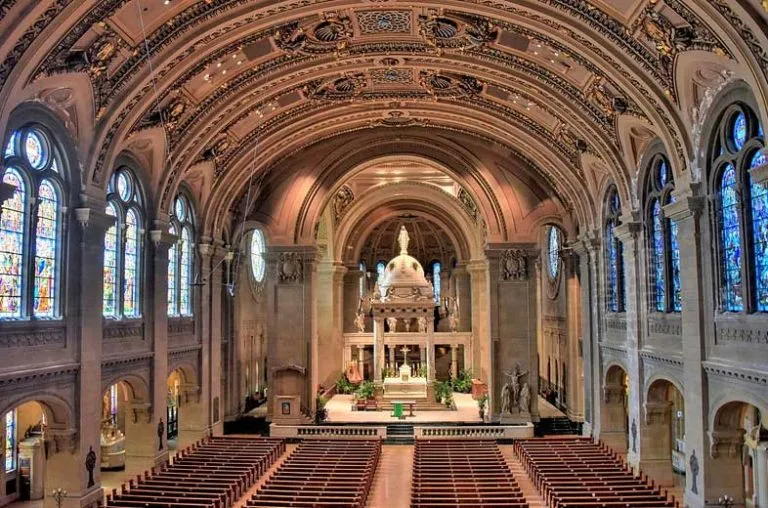
Architecture
Architectural Style: Neoclassical Architecture
The building of the Basilica of Saint Mary, Minneapolis was added to the National Register of Historic Places in 1975. Its significance is due to three reasons: its excellent architecture and engineering design, as an expression of Baroque influence in church architecture; an example of the history of religious movements in Minnesota; and its place as the first basilica in the United States.
The foundation of the church is of Rockville granite. The walls are built of white Vermont granite, with a height of 70 feet (21 m) from the floor to the eave-line. The main entrance is a colonnaded portico with two 116-foot (35 m) spires on each side. The nave is lighted by five large arched stained glass windows. The nave has a barrel vault of 82 feet (25 m), exceeding that of the St. Peter’s Basilica by two feet.
The sanctuary, at the north end of the nave, is topped with a grand dome measuring 40 square feet (3.7 m2) at the base and rising 138 feet (42 m) above the floor. Above the dome is a flesche or lantern topped with a bronze cross, measuring another 62 feet (19 m), making the total height 200 feet (61 m) above floor level. The marble altar is located underneath a 50-foot-high (15 m) marble-columned baldacchino.
In 1991 its old copper roof was replaced, stopping the water leaks and damage and that were occurring. In 2011, after being named one of 25 Twin City finalists, the building was the recipient of a $100,000 preservation grant from Partners in Preservation, chosen through a public vote; the funds were used to repair the narthex and sacristy of the Basilica, and help restore the paint and gold leaf found throughout the structure.
The Basilica of Saint Mary, Minneapolis received minor fire damage during the rioting that accompanied the 2020 George Floyd protests in Minneapolis–Saint Paul, with two pews being splashed with flammable liquid and burned.
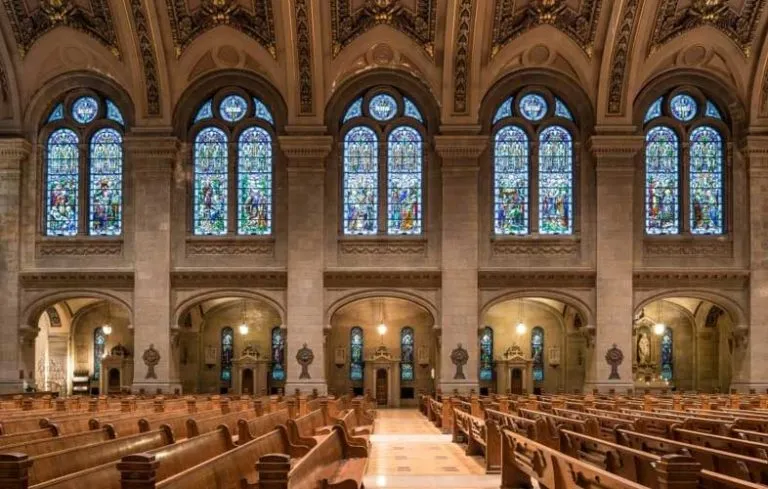
Mary, Mother of God
As the mother of Jesus, Mary accompanied him on his earthly journey, even unto the cross. There Jesus shared his mother with all of us so she became our mother. As a mother Mary has appeared throughout the ages to people who were in need of comfort or correction. Some of The Basilica’s shrines dedicated to Mary relate to her being the Mother of God, others to her being our mother.
When the Irish and Italian immigrant founders of the Parish moved into The Basilica they brought with them Our Lady of the Immaculate Conception. Today, our community is much more diverse. The images of Mary are representative of her many apparitions throughout the world, often in the image of the people to whom she appeared.
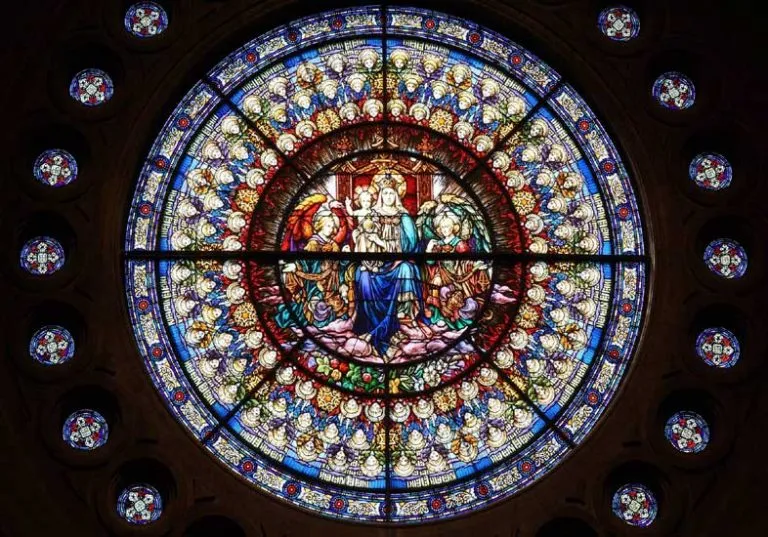
Stained Glass Windows
Art Inspired by Faith and Glowing with Light. Since the 10th century, Stained Glass has been an integral part of church architecture. The idea that God is divine light, filtered through colored and painted glass brings a special aura to the activities held within it. In addition, the vast expanses of the windows have provided a grand canvas for the depiction of the Christian narrative.
The Basilica of Saint Mary Minneapolis windows were designed, executed and installed by Thomas J. Gaytee Studios of Minneapolis. Thomas Gaytee worked under Louis Comfort Tiffany in New York. He originally came to Minneapolis as a salesperson for Tiffany. By 1918 he worked for the Minneapolis based Ford-McNutt Glass Company. When the company was discontinued, Gaytee bought their stained glass materials and started his own company.
In 1924 he completed a first set of windows for The Basilica of St. Mary Minneapolis, including the windows in the dome. In 1925 he began work on all the other windows which he completed by 1926.
Though Gaytee Studios has changed hands twice the company is still in existence. They continue to care for The Basilica windows when needed. Most recently they restored all the windows in the Sacristy.
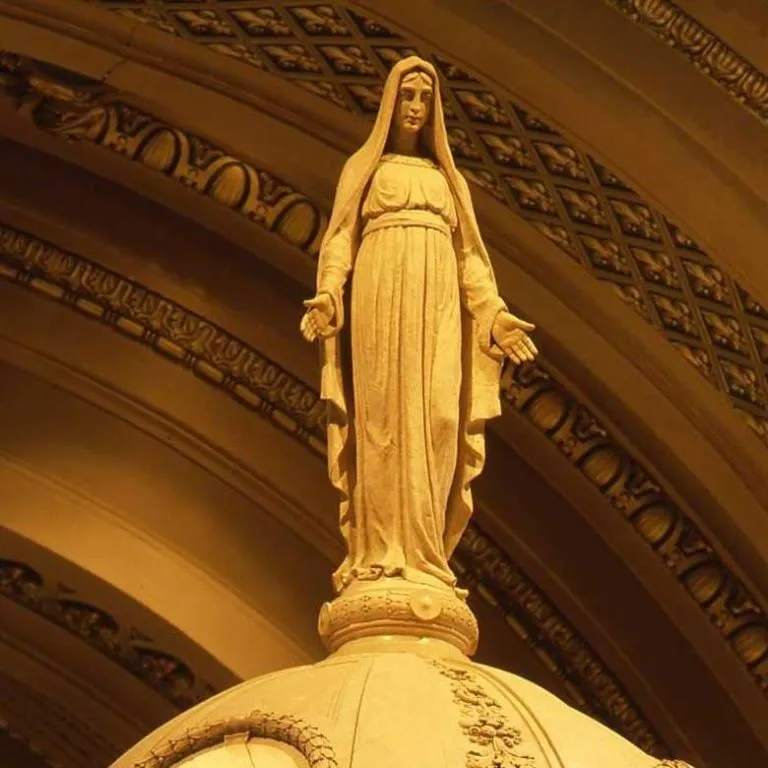
High Altar
The marble altar and baldachin (the canopy over the altar) were designed by Boston architects Maginnis & Walsh, and handcrafted at the Benziger Brothers Studios in Pietrasanta, Italy. Monsignor Reardon describes his vision for the altar in his history of the Basilica: “In finishing the church the major problem was, of course, the main altar.
On its solution everything else depended; for the altar would give meaning and tone to all the rest… For that, the finest marble that money could procure must be available, and the most skillful sculptors commissioned to chisel it into life… The altar must be one of the finest in America in material, design and workmanship.”
Wrought Iron Grill
The elaborate wrought iron grille surrounding the sanctuary was fabricated by the Flour City Ornamental Iron Company of Minneapolis. It contains symbols and stories of the life of Mary. The cipollino marble pillars supporting the grillwork were imported from Italy.
Statues of the Apostles
The marble statues surrounding the Sanctuary depict the apostles. Carved in Italy, they are half size copies of those in St. John Lateran, Cathedral of Rome.
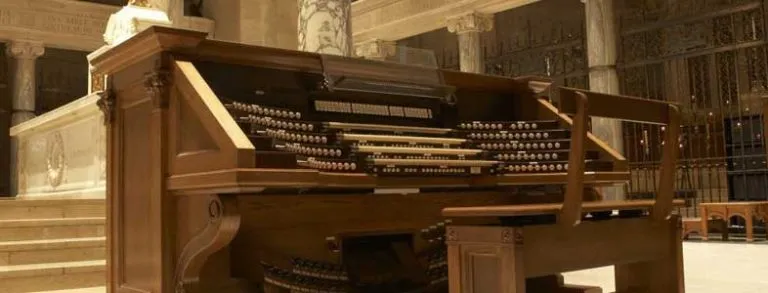
Music : The Basilica Cathedral Choir
The Basilica of Saint Mary, Minneapolis Cathedral Choir, a 90-voice auditioned, volunteer choir provides choral music on Sunday for the 9:30am Mass as well as on Holy Days of Obligation. The Basilica Cathedral Choir sings repertoire spanning a wide range of genres and covering many centuries. Music for vespers, confirmations, and special services is provided by the Schola Cantorum, a 12-voice professional choir.
The present Basilica organ was installed in 1949 as Wicks Opus No. 3047. The instrument includes several stops that were scaled and designed by Henry Vincent Willis IV of England as one of a few larger Wicks instruments installed throughout the United States in the 1930s and 1940s.
After undergoing a complete renovation in Winter, 2008, including an entirely new relay and console, the organ now consists of 82 ranks on 4 manuals and pedal. The en-chamade Herald Trumpet is actually tuba-scale and modeled after the English town hall Willis tubas. Voiced on 25″ wind, it is the most commanding such stop in the Upper Midwest.
Since 1996, the Basilica has hosted a variety of artists and musical ensembles through its artist-in-residence program. As of 2015, the following musical entities were in residence:
- Director of Music Teri Larson
- Composer Donald Krusback
- The Basilica Brass Ensemble
- The Minnesota Sinfonia
- The Rose Ensemble
The Saint Paul Chamber Orchestra also uses the Basilica as a venue.
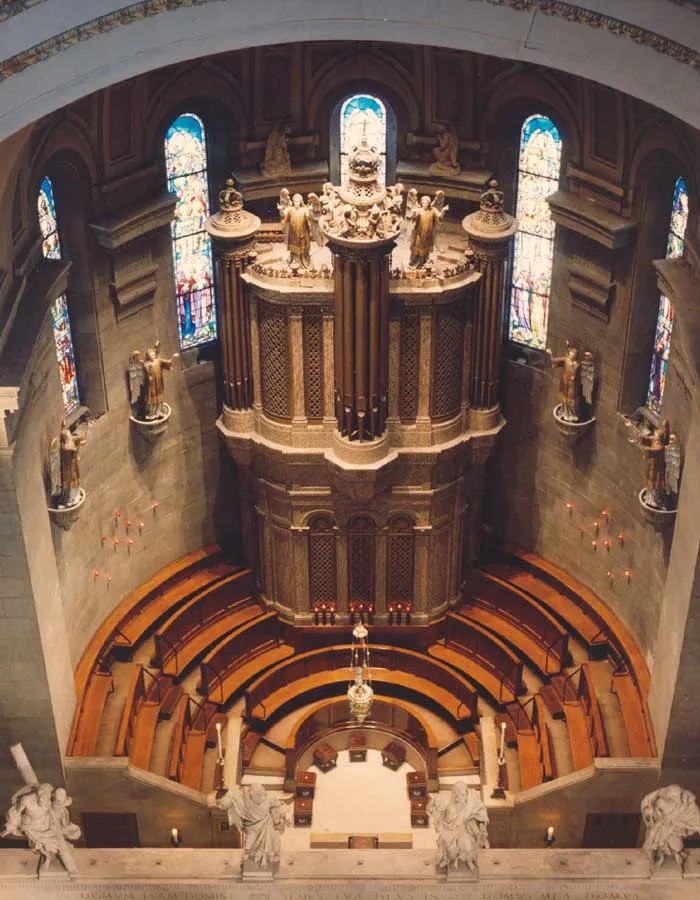
The Basilica Organ / The Centennial Organ
The present Basilica organ was installed in 1949 as Wicks Opus 3047 and was formally dedicated to the Glory of God on October 15, 1950.
Mario Salvador performed the inaugural organ concert to a capacity crowd. Salvador was born in the Dominican Republic and emerged as an internationally-known concert organist who also served as organist at the Saint Louis Cathedral, Saint Louis, Missouri. The October 15 dedicatory concert was televised live on KSTP-TV from The Basilica and was the first remote live television broadcast in the Twin Cities region!
The 1950 dedication of the organ coincided with the centennial of the founding of the Saint Paul-Minneapolis Archdiocese in 1850. The honorary title of “Centennial organ” was bestowed upon The Basilica’s instrument. The Basilica organ is one of a few large Wicks organs installed throughout the United States during the 1930s and 1940s with tonal influence from Englishman Henry Vincent Willis. Willis’ lineage traces back to “Father Willis, ” who remains well-regarded in the history of English organ building.
Holy Trinity, Jesus Christ & the Great Feasts
Basilica Icons – Icons from The Basilica’s chapel, displayed in the sanctuary November 2020.
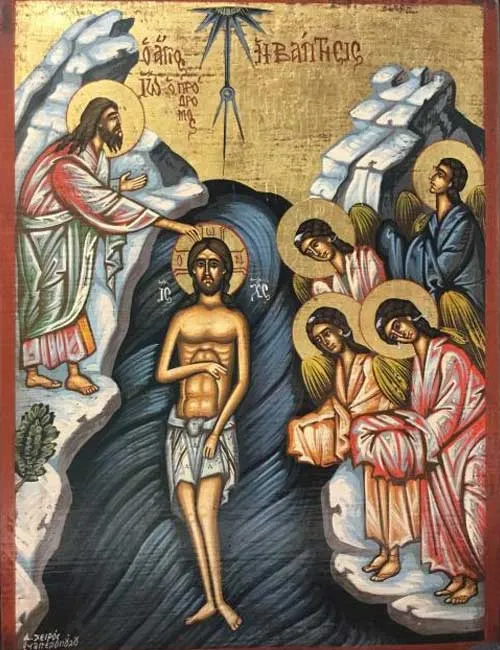
The Theophany / Baptism of Jesus: Jesus’ Baptism by Saint John was the beginning of His public ministry, and a manifestation of the Holy Trinity, hence the name Theophany, “Manifestation of God.”
Feast Day- 8th September
Solemnities and Feasts of Mary
Mary, the Mother of Jesus accompanied him throughout his life, to the very end. Standing under the cross Jesus presented his mother to all of us. Throughout the ages, Mary has shown herself to be a caring mother appearing to those in need of support, encouragement or correction. Throughout the liturgical year we celebrate Mary as the Mother of God and as our Mother.
Among the many celebrations of Mary, here are but a few:
Solemnity of Our Lady of the Immaculate Conception (December 8) celebrates the dogma that Mary was conceived without original sin. This is not only the feast day of the United States but also the patronal feast of The Basilica.
Feast of Our Lady of Guadalupe (December 12) celebrates her appearance to Blessed Juan Diego in 1531 and ongoing miracles. On the Sunday closest to December 12 we celebrate La Guadalupana with a solemn Eucharist and Fiesta.
Solemnity of Mary, Mother of God (January 1) celebrates that Mary was the mother of God because Jesus, while fully human, was divine.
Feast of the Annunciation (March 25) remembers when the Angel Gabriel told Mary she would conceive from the Holy Spirit and bear a son.
Feast of the Visitation (May 31) commemorates Mary visiting her cousin Elizabeth (Mother to John the Baptist) who had conceived as well.
Solemnity of the Assumption of the Blessed Virgin Mary (August 15) celebrates the dogma that at the end of her life Mary was taken to heaven, body and soul. On this day in 1915 The Basilica of Saint Mary was solemnly dedicated.
Feast of the Nativity of the Blessed Virgin Mary (September 8) celebrates the birth of Mary to Anna and Joachim.
Several Additional Celebrations throughout the year.
The Solemnity of the Holy Trinity (Sunday after Pentecost) celebrates the mystery of one God and three persons.
The Solemnity of the Body and Blood of Christ (Sunday after Trinity Sunday) celebrates Christ’s presence in the Eucharist.
The Solemnity of the Sacred Heart of Jesus (Friday after Corpus Christi) celebrates the love of God revealed in the sacrificial life of Jesus.
The Solemnity of Christ the King (final Sunday of liturgical year) looks with hope and confidence toward the end of time when Jesus Christ will judge the living and dead.
Mass Time
Weekdays
Saturdays
Sundays
Church Visiting Time
Other Facilities
Cowley Center
The Cowley Center was designed in 1966 by the architectural firm, Voigt & Fourre as a residence for the Sisters of Saint Joseph of Carondelet who provided instruction at The Basilica School. Unfortunately, the sisters withdrew from teaching at the school a few years later, and the school was closed in 1975. The convent building was leased to various businesses until 1991. In 1993, the building was dedicated to Bishop Leonard P. Cowley, 6th rector of the Basilica, and reclaimed by The Basilica as offices for the development department and meeting rooms.
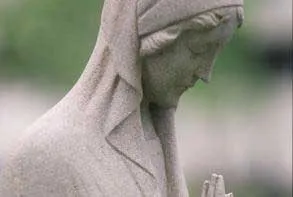
The statue of “Mary, Comfort of the Afflicted” between the Cowley Center and the church was donated by the Sisters of Saint Joseph of Carondelet in 1993. The statue was previously located at Saint Mary’s Hospital.
Reardon Rectory
The Reardon Rectory was erected in 1927-1928 as a residence and business office for the rector and assistant priests of The Basilica. Along with the sacristy, the building was designed by St. Paul architects Slifer and Abrahamson. It replaced two frame houses located on the east side of the church, which served as rectory from 1914 to 1927.
The apartments once occupied by young priests and housekeepers have now largely been converted into offices for the Administrative, Life, Learning and Liturgy department staff, as well as meeting rooms. In 2013, an exterior elevator tower was constructed to replace the original 1928 elevator and provide access to all five floors of the building. In 2015 the fourth floor was remodeled to house our archives and art collection as well as a consultation room and several offices.
The Reardon Rectory is named for Msgr. James M. Reardon, 5th rector of The Basilica (1921 – 1963). The building is included in the National Register of Historic Places Designation conferred in 1975 on The Basilica church and campus.
Contact Info
88 N 17th St, Minnesota,
Minneapolis, MN 55403, United States
Phone No.
Tel : +1 612-333-1381
Accommodations
How to reach the Basilica
The nearest airport to Shattuck-Saint Mary’s is Minneapolis (MSP) Airport which is 40.3 miles away. Other nearby airports include Rochester (RST) (47.1 miles), Mason City (MCW) (80 miles) and La Crosse (LSE) (103.9 miles).
The nearby Light Rail Stations to the Basilica is Warehouse District / Hennepin Ave and Target Field Station.

